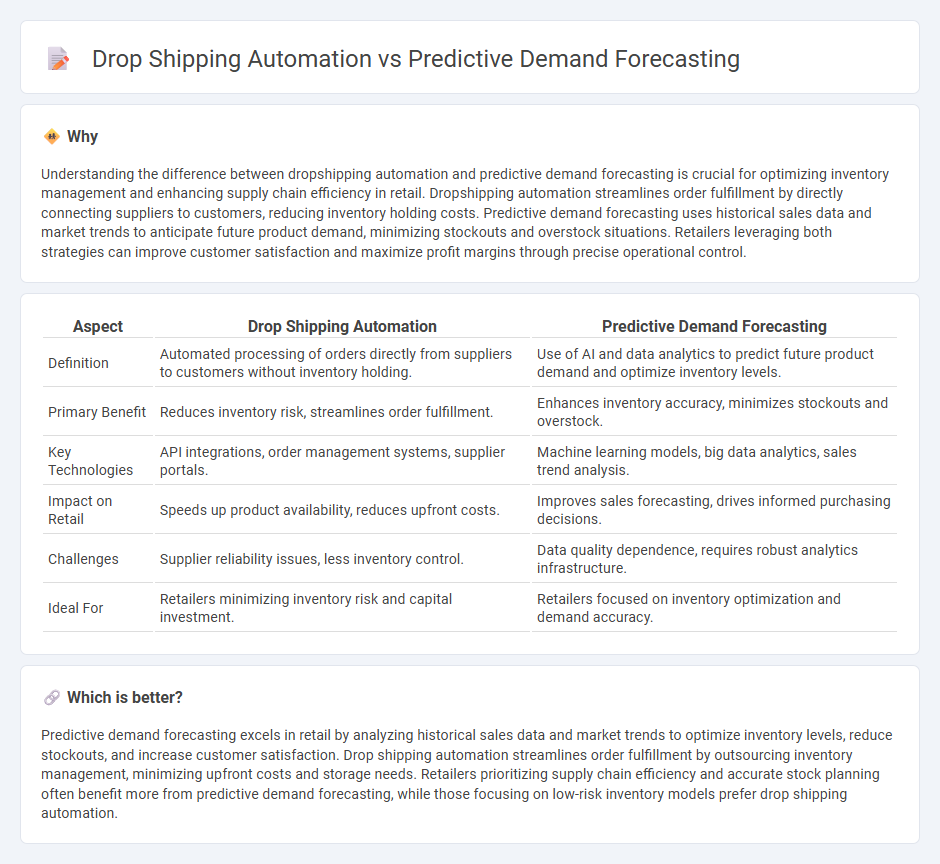
Drop shipping automation streamlines order fulfillment by directly connecting retailers with suppliers, minimizing inventory costs and speeding up delivery times. Predictive demand forecasting uses AI and big data analytics to anticipate consumer buying patterns, optimizing stock levels and reducing waste. Explore how integrating both strategies can revolutionize retail efficiency and profitability.
Why it is important
Understanding the difference between dropshipping automation and predictive demand forecasting is crucial for optimizing inventory management and enhancing supply chain efficiency in retail. Dropshipping automation streamlines order fulfillment by directly connecting suppliers to customers, reducing inventory holding costs. Predictive demand forecasting uses historical sales data and market trends to anticipate future product demand, minimizing stockouts and overstock situations. Retailers leveraging both strategies can improve customer satisfaction and maximize profit margins through precise operational control.
Comparison Table
| Aspect | Drop Shipping Automation | Predictive Demand Forecasting |
|---|---|---|
| Definition | Automated processing of orders directly from suppliers to customers without inventory holding. | Use of AI and data analytics to predict future product demand and optimize inventory levels. |
| Primary Benefit | Reduces inventory risk, streamlines order fulfillment. | Enhances inventory accuracy, minimizes stockouts and overstock. |
| Key Technologies | API integrations, order management systems, supplier portals. | Machine learning models, big data analytics, sales trend analysis. |
| Impact on Retail | Speeds up product availability, reduces upfront costs. | Improves sales forecasting, drives informed purchasing decisions. |
| Challenges | Supplier reliability issues, less inventory control. | Data quality dependence, requires robust analytics infrastructure. |
| Ideal For | Retailers minimizing inventory risk and capital investment. | Retailers focused on inventory optimization and demand accuracy. |
Which is better?
Predictive demand forecasting excels in retail by analyzing historical sales data and market trends to optimize inventory levels, reduce stockouts, and increase customer satisfaction. Drop shipping automation streamlines order fulfillment by outsourcing inventory management, minimizing upfront costs and storage needs. Retailers prioritizing supply chain efficiency and accurate stock planning often benefit more from predictive demand forecasting, while those focusing on low-risk inventory models prefer drop shipping automation.
Connection
Drop shipping automation streamlines order fulfillment by integrating real-time inventory updates directly from suppliers, reducing delays and stockouts. Predictive demand forecasting utilizes historical sales data and market trends to anticipate product demand, enabling automated systems to adjust inventory levels proactively. Combining these technologies enhances supply chain efficiency, minimizes excess stock, and improves customer satisfaction in retail operations.
Key Terms
**Predictive Demand Forecasting:**
Predictive demand forecasting uses advanced algorithms and historical sales data to accurately anticipate consumer purchasing patterns, enabling businesses to optimize inventory levels and reduce stockouts. This method leverages machine learning models that analyze market trends, seasonality, and external factors to improve supply chain efficiency and enhance customer satisfaction. Explore more to understand how predictive demand forecasting drives smarter inventory management and boosts profitability.
Time Series Analysis
Time Series Analysis plays a pivotal role in predictive demand forecasting by analyzing historical sales data to identify patterns and trends, enabling businesses to anticipate future product demand with higher accuracy. In contrast, drop shipping automation leverages Time Series Analysis to optimize inventory replenishment schedules and streamline order fulfillment processes, reducing lead times and minimizing stockouts. Explore how integrating Time Series Analysis can enhance both predictive demand forecasting and drop shipping automation for operational excellence.
Machine Learning Models
Predictive demand forecasting leverages advanced machine learning models such as time series analysis, random forests, and neural networks to analyze historical sales data and predict future product demand with high accuracy. Drop shipping automation utilizes machine learning to optimize inventory management, order processing, and supplier selection in real-time, improving operational efficiency and reducing fulfillment delays. Explore the latest machine learning innovations shaping predictive demand forecasting and drop shipping automation for enhanced supply chain performance.
Source and External Links
Understanding Predictive Demand Forecasting - Graphite Note - Predictive demand forecasting applies historical data, statistical models, and machine learning to predict future demand by incorporating seasonality, trends, promotions, and external factors for greater accuracy beyond traditional methods.
Demand Forecasting: The Ultimate Guide | ThroughPut AI - Effective predictive demand forecasting involves selecting appropriate models from simple averages to AI-driven algorithms, generating forecasts, and continuously reviewing and adjusting predictions based on actual sales and market changes to enhance accuracy.
Predictive Analytics Transforms Real-Time Demand Forecasting - Predictive analytics enhances demand forecasting by detecting trends, seasonality, and anomalies to optimize inventory, improve supply chain efficiency, reduce costs, and elevate customer satisfaction through timely product availability.
 dowidth.com
dowidth.com